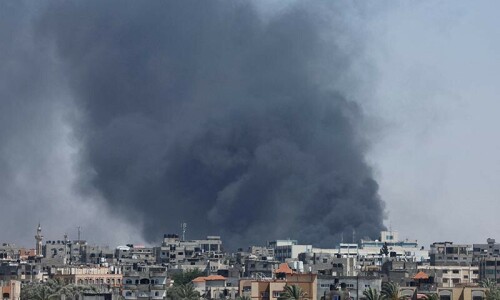THERE’S no dearth in the country of voices lamenting the overtaking of ‘Pakistani culture’ by foreign influences. From as august a platform as the National Assembly, people have at various times called for the state to institute interventions and put in place cultural protectionism mechanisms which could, they argue, ‘save our children from losing touch with their roots’.
This is hardly a concern unique to Pakistan, and many countries have dealt with it in out-of-the-box ways. Consider, for example, the challenges posed by the American cultural industry behemoth to its middling counterpart in Canada, not very differently placed as Pakistan vis-à-vis India. In Pakistan, the result of these concerns have been, at different times and for varying periods, moves such as disallowing Indian films from being screened at local cinemas.
There is, of course, the issue of what exactly ‘Pakistani culture’ constitutes. It is very far from a unitary entity. Further, it is comprised of a whole that amounts to being greater than the sum of its parts. Most problematically for those searching for unique characteristics, it is in many ways analogous to — even indistinguishable from — the cultures on the ‘wrong’ side of international borders.
We have yet to define what Pakistani culture constitutes.
The debate can, however, be framed in broader strokes. Certainly there is an identifiable Pakistani culture, varied and colourful. And certainly, it could do with further promotion. The issue can be seen in terms of not what pressures other, larger cultural industries are subjecting Pakistani culture to, but what this country is doing to promote its own brand.
The primary platforms for the celebration of culture are film, theatre, music and television, in large part. Of these in Pakistan, the last is the largest industry in terms of the volume of money flowing through its veins, the number of people it directly or indirectly employs, and the size of the audiences it reaches. It is, therefore, a significant reflector of the culture we wish to promote and project.
Forget, for the moment, the fact that what plays out on our television screens in entertainment programming for adults is, barring a few exceptions, in the main regressive, patriarchal and parochial. If being in touch with the local culture starts at a young age, what is domestic television programming offering those millions that constitute what leaders and policy planners love referring to as ‘the future of the country’? Sadly enough, not much. Not even as much as was the case in years past.
Of the 100-plus channels that most households in Pakistan’s urban areas have access to, there are a few exclusively for kids. But there is no domestically produced content to speak of for either children or young adults. India, by contrast and perhaps unsurprisingly, has a massive footprint. Cartoons franchises from different parts of the world (such as Dora in the US, the Japan-produced Doremon and countless others) have been dubbed into Hindi and that constitutes a large part of what Pakistani children watch; there are art shows and magic shows; there are also a good number of drama series for older children and young adults, with child actors and especially commissioned scripts.
The quality of these shows is debatable. But the fact remains that in terms of the sheer volume, the air waves here for children are dominated by Indian content and culture. Thus, as was pointed out in a seminar on the subject organised last November by a private school and university network, Pakistan’s children are absorbing words and phrases that are at odds with Urdu and any of the other local languages — ‘sunder’ instead of ‘khoobsurat’, for example, or ‘shakti’ instead of ‘taqqat’; the mythology they are watching does not refer to what dominates here, and so on.
In itself, this is not a problem. I would never argue that exposure to other cultures, religions and practices is in any way problematic. But the issue is, what are the so-called custodians of Pakistan culture (the television networks, the directors, producers, scriptwriters etc) and its promotors (eg those who decry the overtaking of ‘our’ culture by foreign interventions) doing to entertain, inform and educate future generations about the fabric that is Pakistan?
Frustratingly, not too long ago, productions for children and young adults were being created. Till as late as the early ’90s, locally produced drama and music shows — as well as some offerings from other cultures — for the younger age bracket were broadcast. They seem to all have disappeared, victim perhaps to the superficial thinking that children’s programming is not lucrative. Where private television networks are patently not interested in this area of operations, neither does the state-run PTV appear so inclined in terms of entertainment (a few education-oriented productions are available).
How many ways are there to fail not just future generations but the future itself? In Pakistan, one can just carry on counting.
The writer is a member of staff.
Published in Dawn, January 18th, 2016










































